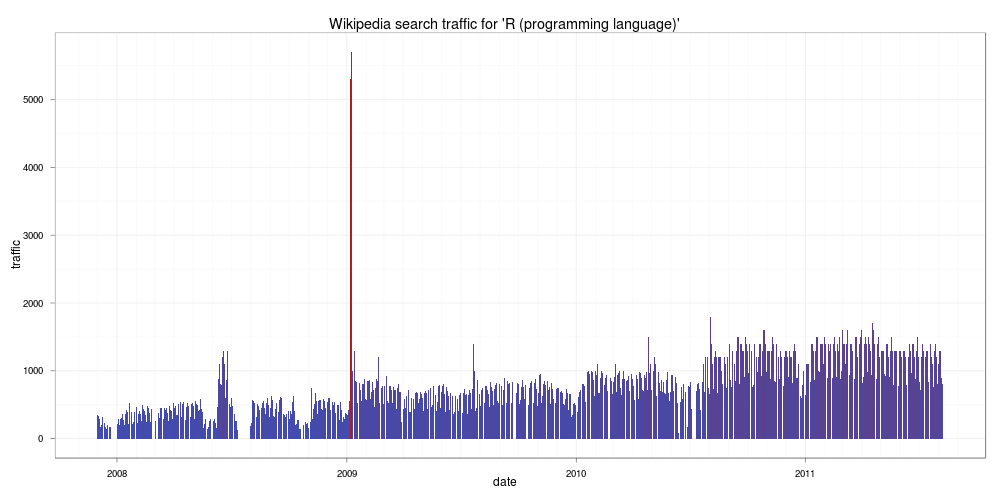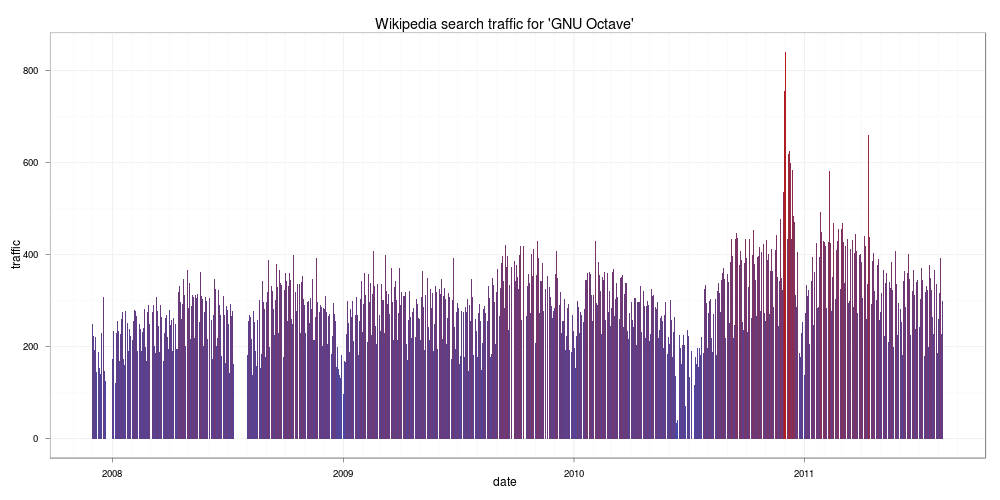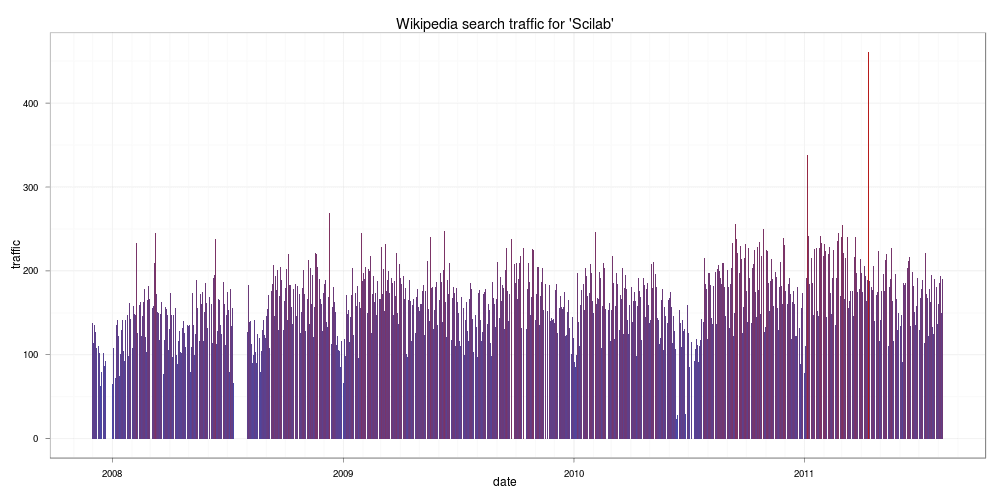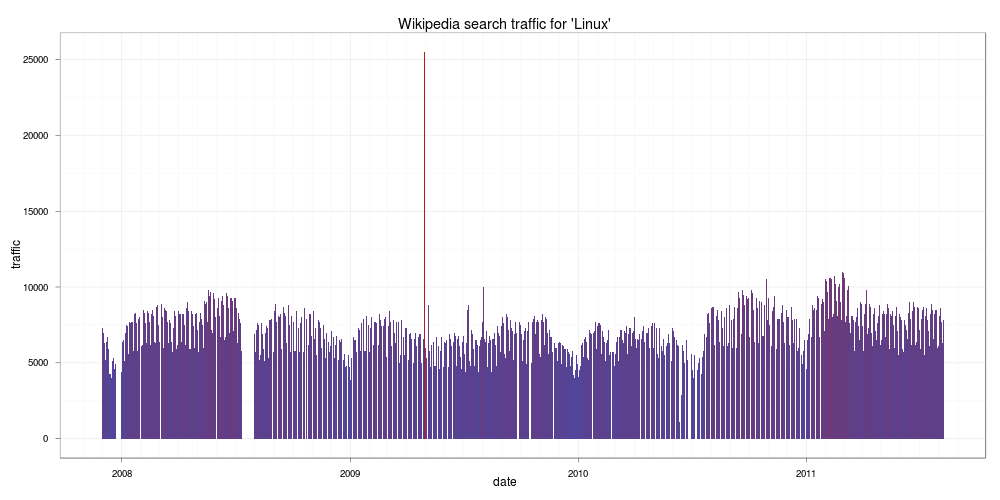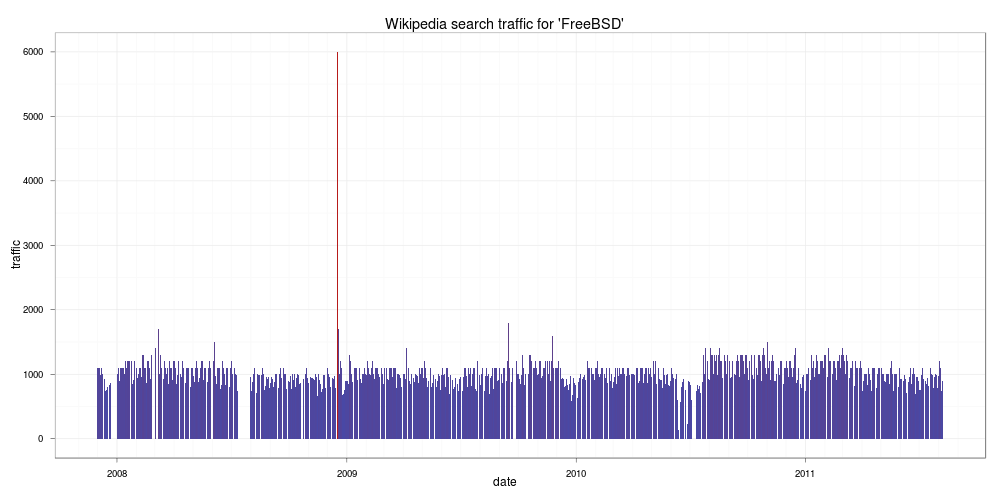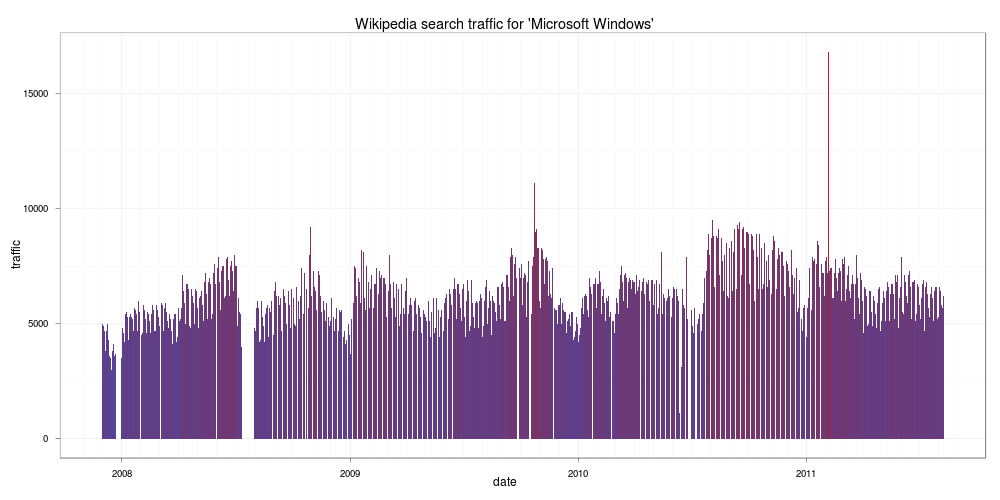Wikipedia 是一個全世界人都在使用的百科全書,我們可以從 Wikipedia 上面各個主題的使用狀況來分析出一些有趣的結果,例如軟體的普及程度等,另外也可以用來作為判斷軟體是否具有發展性的一個參考。
這裡我們針對矩陣計算軟體、作業系統等議題,分別使用 R 來抓取 Wikipedia 上面的使用資訊,並畫出圖表來分析,看看這些領域目前的情況。
矩陣計算軟體
首先來看 R 軟體本身的情況,下面這張是 R 語言近幾年在 Wikipedia 上面被查詢的狀況:
由這張圖可以看出來在這幾年中對 R 語言有興趣的人有成長的趨勢,而在 2009 年一月份因為紐約時報登了一篇關於 R 的文章,所以當月的瀏覽量突然暴增,由於增加的量相當驚人,原作者還一度以為是 bug。
接下來我們再來看看 Octave 與 Scilab 兩個軟體的情況,這兩個軟體也是跟 R 很類似的軟體,首先是 Octave:
由圖中情況看起來,似乎對 Octave 有興趣的人沒有 R 來的多,再來看看 Scilab:
看起來比 Octave 更慘,如果您正在考慮學習哪一種矩陣計算工具,這個結果值得參考一下,畢竟使用者的多寡對於軟體的發展有一定的影響力,使用者太少的軟體,其發展與除錯的速度相對的會比較遲緩。
作業系統
首先來看最近很熱門的 Android:
看來從 Google 一推出後,對於 Android 有興趣的人不斷上升,到了 2011 之後,似乎增加的速減緩了。接著來看 Linux:
看起來都是很穩定的樣子。跟 Linux 很像的 FreeBSD:
也是很穩定沒什麼變化,但是跟 Linux 比起來就差一大截。接著看一下微軟的 Windows:
可能微軟的 Windows 已經家喻戶曉了,所以上 Wikipedia 查 Windows 的人沒有非常多,跟 Linux 差不多。最後來看個有趣的 iPad:
在 2010 年年初 iPad 剛上市時造成轟動,瞬間的查詢量非常高,隨後就降下來,跟 Google 推出的 Android 相比截然不同,也許是兩家公司的行銷手法不一樣所導致的。
R 程式碼
以下是用來分析的 R 函數原始程式碼:
wikiStat <- function (query, lang = 'en', monback = 12, since = Sys.Date() ) { #load packages require(mondate) require(XML) namespace <- c("a" = "http://www.w3.org/1999/xhtml") wikidata <- data.frame() #iterate "monback" number of months back for (i in 1:monback) { #get number of days in a given month and create a vector curdate <- strptime(mondate(since) - (i - 1), "%Y-%m-%d") previous <- strptime(mondate(since) - (i - 2), "%Y-%m-%d") noofdays <- round(as.numeric(previous - curdate), 0) days <- seq(from = 1, to = noofdays, by = 1) #build url if(curdate$mon + 1 < 10) { dateurl <- paste(as.character(curdate$year + 1900), "0", as.character(curdate$mon + 1), sep = "") } else { dateurl <- paste(as.character(curdate$year + 1900), as.character(curdate$mon + 1), sep = "") } url <- paste("http://stats.grok.se/", lang, '/', dateurl, '/', query, sep = "") #get and parse a wikipedia statistics webpage wikitree <- xmlTreeParse(url, useInternalNodes=T) #find nodes specifying traffic traffic <- xpathSApply(wikitree,"//a:li[@class='sent bar']/a:p", xmlValue, namespaces = namespace) #edit obtained strings (sometimes its in the format # of e.g. 7.5k meaning 7500) traffic <- gsub(".", "", traffic) traffic <- gsub("k", "00", traffic) traffic <- as.numeric(traffic) #it seems that there is some kind of a bug in wikipedia statistics #and the results are shifted by one day in a month - this is a fix if(length(traffic) > noofdays) { traffic <- traffic[2:length(traffic)] } #create daily dates relating to traffic vector #and create a dataframe days <- seq(from = 1, to = length(traffic), by = 1) yearmon <- rep(paste(curdate$year + 1900, curdate$mon + 1, sep = "-"), length(traffic)) date <- as.Date(paste(yearmon, days, sep = "-"), "%Y-%m-%d") wikidata <- rbind(wikidata, data.frame(date, traffic)) } #remove rows that are missing (due to the bug?) wikidata <- wikidata[!is.na(wikidata$date),] #return dataframe return(wikidata) } wikiPlotStat <- function(wikitraffic, title = "Wikipedia statistics") { require(ggplot2) #create a plot wikiplot <- ggplot() + geom_bar(aes(x = date, y = traffic, fill = traffic), stat = "identity", data = wikitraffic) + opts(title = title) #...with no legend and a theme that fits colours of my blog ;) wikiplot <- wikiplot + theme_bw() + opts(legend.position = "none") return(wikiplot) }
在使用前要先確定 mondate 與 XML 這兩的套件有沒有裝,若是沒有裝就要先裝才能使用:
install.packages("mondate") install.packages("XML")
然後就將上面兩個函數的定義複製貼到 R 中執行,或是存成一個 R 程式檔 script.R,使用 source 的方式:
source("script.R")
接下來就可以開始分析了,例如要分析 “R_(programming_language)” 在 Wikipedia 上面被查詢的狀況:
ar <- wikiStat("R_(programming_language)", monback = 45, lang= 'en') wikiPlotStat(ar, "Wikipedia search traffic for 'R (programming language)'")
因為在分析時 R 要從網路上抓取資料,所以分析的時間會比較久,網路比較慢的人要比較有耐心。
參考資料:
Visualising Wikipedia search statistics with R
R popularity – steady growth and New York Times


